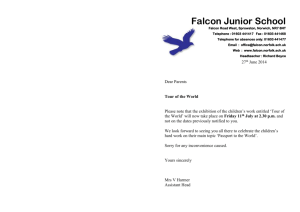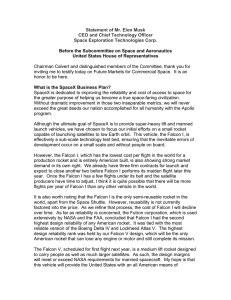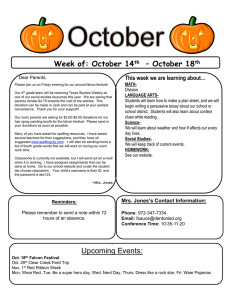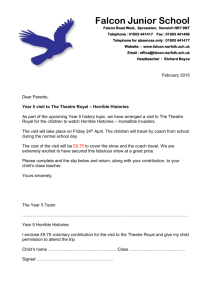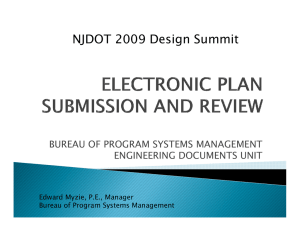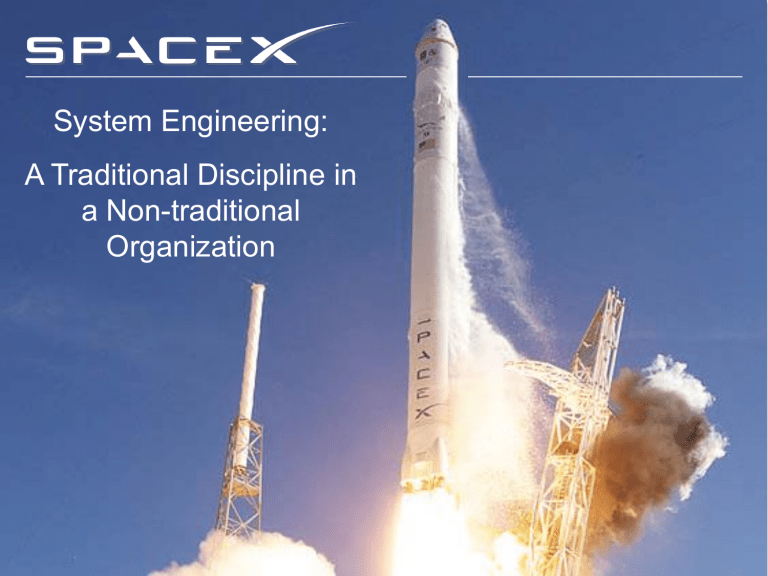
System Engineering:
A Traditional Discipline in
a Non-traditional
Organization
Corporate Overview
•
•
•
•
•
•
•
Founded with the singular goal of providing highly
reliable space transportation
Tech-style Organization—Flat and Fast
1,750 employees and growing
Nearly 1 million sq. ft. of offices, manufacturing and
production in Hawthorne, California
>1 square mile (2.5 square km) state-of-the-art
Propulsion and Structural Test Facility in central Texas
Launch sites at Cape Canaveral and Vandenberg
Commercial launch site nearing selection
SLC-40, Cape Canaveral
Central Texas
Hawthorne (Los Angeles) Headquarters
9/28/2012
© Space Exploration Technologies Corp.
SLC 4, Vandenberg
Page 2
SpaceX Large Scale Developments
Falcon 1
9/28/2012
Falcon 9
© Space Exploration Technologies Corp.
Falcon Heavy
Page 3
Dragon Spacecraft
Falcon Launch Vehicle Evolution
Falcon 9
Dragon
Falcon 9
5.2 m Fairing
Falcon Heavy
5.2 m Fairing
Falcon 1
•
•
•
•
•
•
F1 and F9 share similar architecture
F1 and early F9 use nearly the same Merlin 1C engine
Advanced F9 uses evolution (Merlin 1D)
Evolved family of software and avionics
Similar launch and ground operations
Lessons learned from Falcon 1 applied to Falcon 9
9/28/2012
© Space Exploration Technologies Corp.
• Falcon Heavy’s first stage will be made up of three nine-engine
cores, which are used as the first stage of the Falcon 9
• Same second stage as Falcon 9.
• Falcon Heavy can deliver 53 metric tons to Low Earth Orbit
• Cross-feeding of propellant leaves core stage nearly full on
booster separation
Page 4
Five Successes in a Row
Falcon 1
Flight 4
28 Sep 2008
Falcon 1
RazakSAT
14 Jul 2009
Falcon 9
Demo Flight 1
4 Jun 2010
33 Merlin engines flown successfully
9/28/2012
© Space Exploration Technologies Corp.
Page 5
Falcon 9 Demo Flight 2
Dragon COTS C1
8 Dec 2010
Falcon 9 Demo Flight 3
Dragon COTS C2
22 May 2012
Premise: Systems Engineering is a discipline established to
protect the enormous investment of large scale, complex system
development by anticipating and solving integration problems
ahead of time
And yet--history has shown that humans are very poor at anticipating all
potential integration problems, especially in new systems
Central Philosophy
• SpaceX is a systems oriented culture whose goal is the engineering and integration of
reliable and safe systems
• SpaceX operates on the philosophy of Responsibility—no engineering process in
existence can replace this for getting things done right, efficiently
• There is an important balance between heavy up front systems engineering and rapid
prototyping to reduce systems risk—tipping point heavily dependent on organizational
agility, cost of iteration, and the ability to trade lower level requirements
• Because we can design-build-test at low
cost (21st century infrastructure) we can
afford to learn through experience rather
than consuming schedule attempting to
anticipate all possible system interactions
• Design a testable system and test what
you fly!
• Test rigorously and at multiple levels
of integration—including right before
service
9/28/2012
© Space Exploration Technologies Corp.
Page 7
Some Examples of ―Iterative Design‖: Engine Controller
Previous Design
9/28/2012
© Space Exploration Technologies Corp.
Current Design
Page 8
Some Examples of ―Iterative Design ‖: Engine
Previous Design
9/28/2012
© Space Exploration Technologies Corp.
Current Design
Page 9
Maintain continuous design heritage in
development with within rapid spiral
methodology
Merlin
1A F1
F1
F9
Merlin 1C
F9 - MVAC
F9
F9 1.1
Commercial
F9 1.1 USAF/LSP
Joint cert
Merlin 1D F9 1.1
Commercial
F9 1.1
Commercial
Crew
Certification
start
Falcon 1 and Falcon 9
??
Merlin
1C F1
Merlin 1D F9 1.1
USAF/LSP Joint cert
start
Merlin 1D F9 1.1
Commercial
Crew
Certification
Merlin 1A (Falcon 1), Merlin 1C (Falcon 1 & 9) and
Merlin 1C Vacuum (Falcon 9)
10
More Specifics:
•
•
•
Distribute systems level tasks to departments to get departments
focused on systems thinking
Follow up with a network of integrators spread throughout the
company
User requirements are tracked and verified but everything below
these requirements is constantly traded and optimized during the
design phase
•
Use modern 21st century
information system tools to
replace traditional control
boards as forum for
discussion and integration –
use a paradigm more
similar to social networking
• Focus on TOOLS NOT
RULES
• Test rigorously and often
9/28/2012
© Space Exploration Technologies Corp.
Page 11
User requirements are tracked and verified but everything below these
requirements is constantly traded and optimized during the design phase
SpaceX
Traditional Vee
Top Level
Requirements
(Level 2)
Integrated
Verification
(Level 2)
Decomposition
Derived
Requirements
(Level 3)
Derived
Requirements
(Level 4)
Integrated
Verification
(Level 2)
Integration
Integration
Verification
(Level 3)
Decomposition
Top Level
Requirements
(Level 2)
Integration
Verification
(Level 4)
Component
Design
Systems
Engineering
Identify Key
Design
Parameters
Qualify units to
predicted/measured
environments
Adjust Key
Design
Parameters For
Optimum System
Performance to
meet Top Level
Requirements
Integration
Model & Analyze
Build &
Development Test
Monitor Key
Parameters
Possible to trade key design parameters between subsystems to optimize results because designers not
separated by contract-subcontract bounds
9/28/2012
© Space Exploration Technologies Corp.
Page 12
Speed of Key Design Parameter Trades
enhanced because of limited
subcontracts
If SpaceX performed
traditional decomposition
Traditional
A
B
E
SpaceX
D
C
F
G
C
H
SpaceX
I
E
SpaceX
SpaceX
SpaceX
SpaceX
SpaceX
SpaceX
SpaceX
>70% of rocket dry mass is built in-house at SpaceX from raw materials
13
SpaceX learns through experience rather than attempting
to anticipate all possible system interactions
Traditional Developments Use Single Cycle to Product—This Mandates
Heavy Systems Engineering to Protect the Design-Build-Test Investment
Test Experience
SpaceX relies on rapid design-build test cycles to inform design by experience
Plan
Design
Build
Test
Test
Plan
Design
Build
Test
Experience
Test
Experience
Plan
Design
Build
Test
Test Experience
Documentation and process becomes more formal as systems move into later cycles
Final qualification, first flight and production
9/28/2012
© Space Exploration Technologies Corp.
Page 14
Test Like You Fly, Test What You Fly
Integrated testing tools are a key investment and provide points where integration is assessed
and ensured using a ―Test Like You Fly‖ approach
•
•
•
•
•
Ironbirds at Hawthorne – hardware–software integration
McGregor engine test – engine and avionics integration in real dynamics environment
McGregor stage test firing– tanks, plumbing, avionics and propulsion integration in real
dynamics environment
Launch Site Hardware in the Loop Simulations - hardware-software integration with all
system components
Launch Site Wet Dress Testing and Static Fire - hardware-software integration with all
system components in real dynamics environment
Engine Test and Stage Firing at McGregor and Static Firing at Pad
Flexible test hierarchy increases formality
as product matures
•
•
•
•
Development Tests used to determine hardware capability in excess of requirements and
to find weaknesses (running at extended temperatures, ultimate strength tests)
Qualification tests demonstrate hardware performance limits (worst case flight conditions
plus required factor of safety or margins). Qualification tests are performed every
design/environment combination
Acceptance Tests verify workmanship and functionality. All hardware acceptance tested
HITL – Hardware in the Loop – shows hardware-software integration. Run for every
hardware-software change
M1C Merlin
Engine
Foreign Object
Ingestion
Demonstration
Test
Thermal
qualification of F9
separation system
Development Test –
Composite Overwrap
Pressure Vessel Ultimate
Thermal qualification test
of Dragon Claw –
connection between
Dragon and Trunk
F9 First Stage
Qualification Tank at
McGregor, TX
Second Stage
Acceptance Test
Flight 3 – McGregor, TX
Component, Assembly and End to End Testing
Draco (Dragon Thruster)
Acceptance Testing
Merlin Nozzle Carbon
Coating Development Test
Dragon Trunk – Falcon 9
Second Stage Separation
Qualification Test
DragonEye – Dragon Rendezvous Thermal Sensor) Shuttle
Development Flight Test
9/28/2012
© Space Exploration Technologies Corp.
Space Station End To End
Communications Testing
Page 17
Test Process at SpaceX
Falcon 9 - Development and Qualification Testing
Avionics
Component
Development
Testing
Propulsion
Component
Development
Testing
Engine
Development
Test
Programs
Post-Test and Post-Flight Analysis
Structures
Component
Development
Testing
Avionics
Component
Qualification
Testing
Propulsion
Component
Qualification
Testing
Engine
Qualification
Test
Programs
Structures
Component
Qualification
Testing
Primary
Structures
Qualification
Proof Testing
Avionics
Component
Acceptance
Testing
Propulsion
Component
Acceptance
Testing
Engine
Acceptance
Test
Programs
Structures
Component
Acceptance
Testing
Primary
Structures
Acceptance
Proof Testing
Test and Flight
Data
Evaluation
Test Location Key:
HardwareSoftware
Integration
Tests
(Ironboid)
Integrated
Stage Firing
ON Vehicle
Hardware In
The Loop and
Polarity Tests
Offline GN&C
Simulations
Falcon 9 - Flight Articles
Launch Wet
Dress
Rehearsal
(WDR)
Pad Static
Firing
Launch
Hawthorne, CA
McGregor, TX
Launch Site
Flight Readiness Review Process
Closing Thoughts
• It is difficult to build a creative high performance engineering
culture
• It is really easy to ruin the creativity and performance by too
much organization, rules and process
• SpaceX is achieving a good balance of creativity and systems
engineering for agility and affordability
9/28/2012
© Space Exploration Technologies Corp.
Page 19

